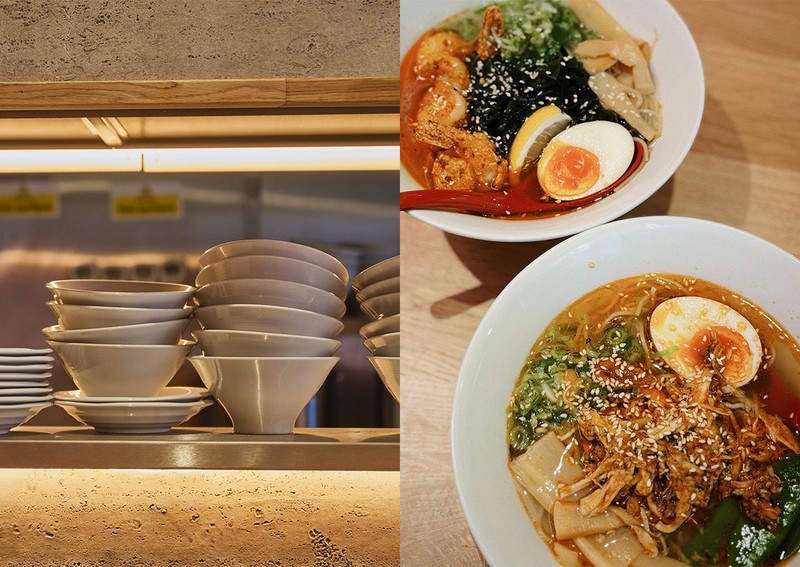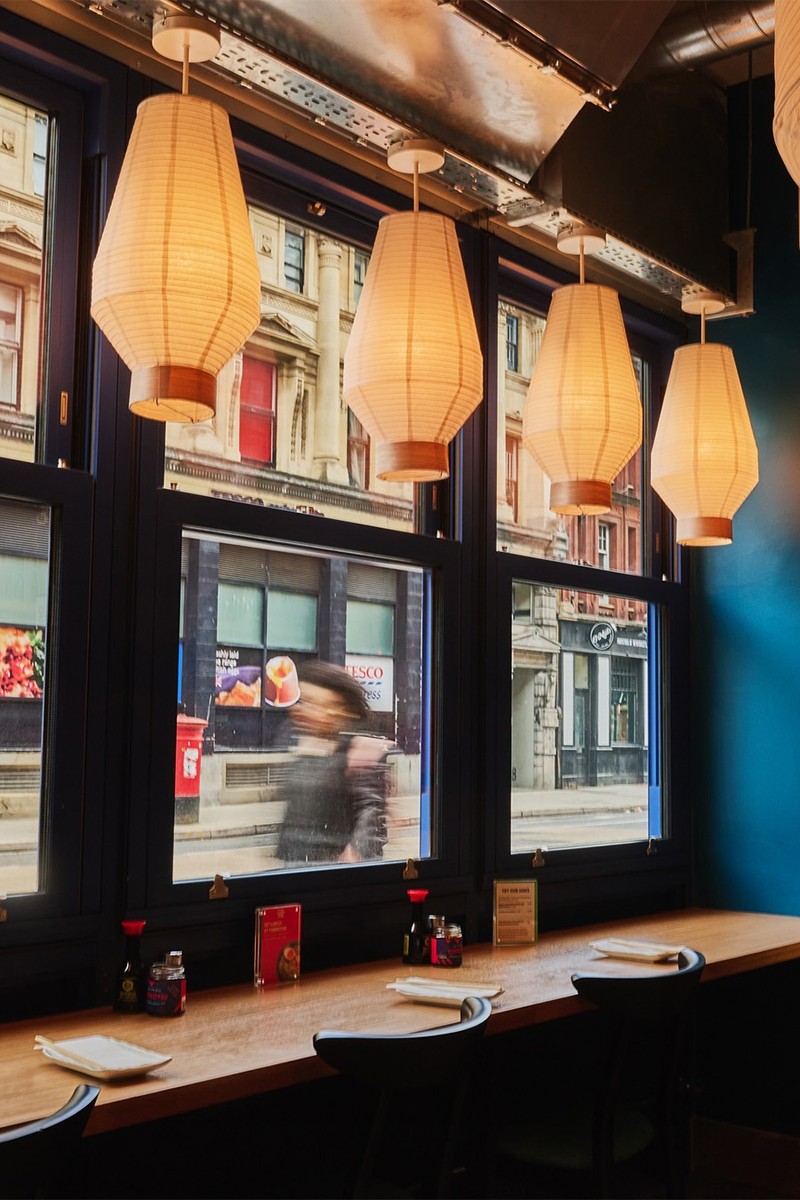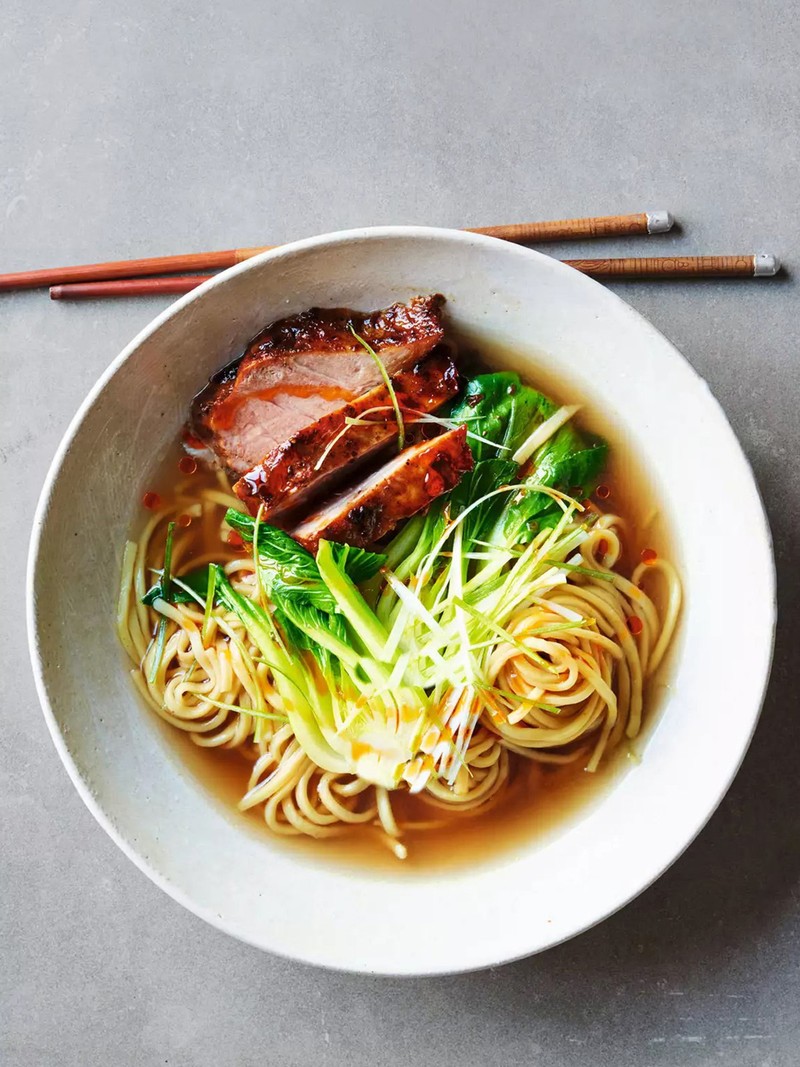
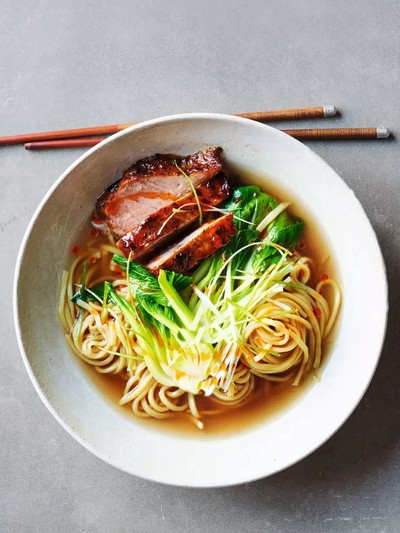
How To Make Good Ramen At Home
First, Tonkotsu’s Ken Yamada explains the basics…
Broth
Like with any broth, the most important thing is the quality of the meat and bones you use. Put a kilo of chicken bones and wings in a pot with three litres of water and boil for around three hours. We add spring onions, ginger, garlic and onions, which are roasted first to enrich the broth. Be careful not to let the broth boil over. Skimming impurities is also key to keeping a clear stock and will help produce a beautiful, golden chicken broth without bitterness.
Flavourings
Tare is a very concentrated seasoning; soy sauce-based tare and salt-based tare are the two most common types. At Tonkotsu, we don't season the broths while they are boiling, as chickens and chicken bones contain minerals and salts in varying degrees, so you can never be sure what is needed to season the broth. The best course of action is to season with tare on a batch-by-batch – or bowl-by-bowl – basis. No size fits all. You can taste your broth to see how much tare is needed for flavour.
Garlic oil also really enhances the ramen's flavour. We first roast fresh garlic and dried garlic slices in our ovens, then fry them in rapeseed oil. It is then blitzed to a smooth, dark garlic oil using a blender. You can also use pork fat to flavour instead.
Noodles
My general rule of thumb is to use thin noodles for thick broths – like a tonkotsu broth – and thicker noodles for loose broths, like a chicken broth. But I have eaten different combinations in ramen joints across Japan, so there really are no rules.
Boiling water is key to a good noodle. When cooking noodles at home in a small pan, adding them to the boiling water will instantly lower the water's temperature. Similarly, if the fresh noodles were kept in the fridge, you should bring them to room temperature before cooking. If the water isn't boiling, the noodles don't cook properly. Use the biggest pan you have with as much water as possible and make sure it is properly, vigorously boiling.
Toppings
For a classic ramen egg, pierce a small hole in the rounded side with a pin (this lets air escape to prevent cracking), then boil in already boiling water for six minutes. Cool under cold water, peel and halve before adding to the dish. For extra flavour, marinate in dashi (an umami-rich stock used in miso soup) for 24 hours in the fridge, letting the flavour fully infuse before serving.
The simplest and least wasteful way to add meat to your ramen is to prepare your chicken broth using a whole chicken. Boil the chicken until tender, then remove, cool and shred the meat for ramen toppings. Return the bones to the pot to deepen the broth’s flavour. This method adds hearty flavour to the soup while providing tender chicken as a topping.
Char siu, often made with pork shoulder or belly, is a popular ramen topping. First, roast the pork, then braise it in a soy-based marinade to infuse rich flavour. Let it chill overnight for a deeper taste, then slice thinly.
The options for vegetable toppings are wide-ranging. Finely sliced spring onions bring freshness, while seasoned bamboo shoots like menma or shinachiku add traditional flavour and crunch. Nori seaweed lends an umami kick that enhances the broth, and tofu is a great vegan addition.
Assembling
To assemble the bowl, mix the broth with the tare, pile in the noodles and finish quickly with the flavoured oil, meat, eggs and other toppings of your choice.
Visit TONKOTSU.CO.UK
Now we have some quick tips from other pros…
Akira Shimizu, exec chef at Akira
"A simple miso ramen is so comforting and very easy to make. To create the broth, stir together miso, soy sauce, water, chopped ginger, garlic, spring onion, and simmer. You can also add vegetables such as cabbage and carrots. Bring a pan of salted water to a boil and cook the noodles until slightly tender. Serve your broth in a deep bowl, topped with the noodles and vegetables, then garnish with chilli, chopped spring onions and sesame seeds for maximum flavour."
Visit JAPANHOUSELONDON.UK
Kanji Furukawa, exec chef at Shoryu Ramen
"Perfect ramen noodles need lots of boiling water to help the noodles cook at the right temperature – for two portions, you'll need about two to three litres of water. If you use less water, as you add more noodles, the temperature will drop, and the noodles won't cook properly. The perfect time for cooking noodles at Shoryu is 45 seconds – so get your timer out. And don't forget to loosen your noodles as you add them to the boiling water, otherwise they will stick. To keep your soup and noodles piping hot, warm up your ramen bowls with boiling water, then empty just before dishing up and serving.
"Some of my favourite toppings are garlic chips, fried onions and bean sprouts. For those who want more of a spicy kick, you can add sriracha sauce to the soup and fresh jalapenos too. Be creative with your toppings – there are hundreds of different variations in Japan. At Shoryu, we like to have a nitamago egg with ginger, or you can try seaweed, miso and sweetcorn as they do in Hokkaido. It's a limitless, fun and great way to use up leftover vegetables from your kitchen."
Visit SHORYURAMEN.COM
Loic Leguay, head chef at Bone Daddies
"Cook the broth slowly. You can use whole chicken wings and legs or a whole chicken – the higher quality, the better, and always free-range – to make the stock rather than finding carcasses. You can then reuse the meat for a marinated topping.
"Noodles come down to personal preference – any kind of noodle will work as long as your broth is delicious. My favourite is udon, but rice noodles are a great alternative to make your ramen gluten-free.
"When it comes to toppings, bamboo shoots from a tin work great, and I like a simple scattering of finely chopped spring onions for freshness and crunch. You can use your chicken meat leftover from making the stock and – of course – don't forget an egg.
"With the broth, you can't cut corners – you won't develop flavour, and it won't be the right consistency. It's the heart of the dish. You could save time with toppings by getting pre-cooked or pre-made items, but a great bowl of ramen really is about how much time and effort you put in."
Visit BONEDADDIES.COM
Inspired? Here are four recipes to try at home…

Sticky Pork Ramen
Preheat the oven to 200°C/Gas Mark 6 and roast the pork in its foil tray for 20 minutes. Meanwhile, put the dashi into a large saucepan with the ginger and bring to a simmer for five minutes.
Pour the pork cooking liquor into the dashi, then spread the sticky sauce over the meat and roast for five minutes. Meanwhile, add the noodles to the dashi and lay the pak choi on top, cut sides up. Cover the pan and simmer for three minutes, until the pak choi is tender.
Slice the pork thickly and keep any sauce. Put the noodles, pak choi and broth into large bowls, top with the pork, remaining sauce and a mound of salad onions.
Drizzle with a bit of chilli oil to taste and serve. Toss to mix, and add more chilli oil if you like your ramen really spicy.

Miso Chicken Ramen
Peel and finely slice the onion. Thinly slice the chilli. Trim the sugar snap peas.
Heat the vegetable oil in a medium-sized pot over medium heat. Add the sliced onion and sauté for 3-4 minutes until it softens.
Add the chicken pieces to the pot and cook for 5-6 minutes until browned and nearly cooked.
Pour in the chicken stock and bring to a simmer. Cook for 5 minutes.
Stir in the miso soup paste and soy sauce, then add the sugar snap peas and noodles.
Simmer until the noodles are tender and the chicken is fully cooked.
Roughly chop the fresh coriander and stir it into the broth.
Finely slice the red chilli and use as a garnish, if desired. Serve the broth hot, with more coriander on top.
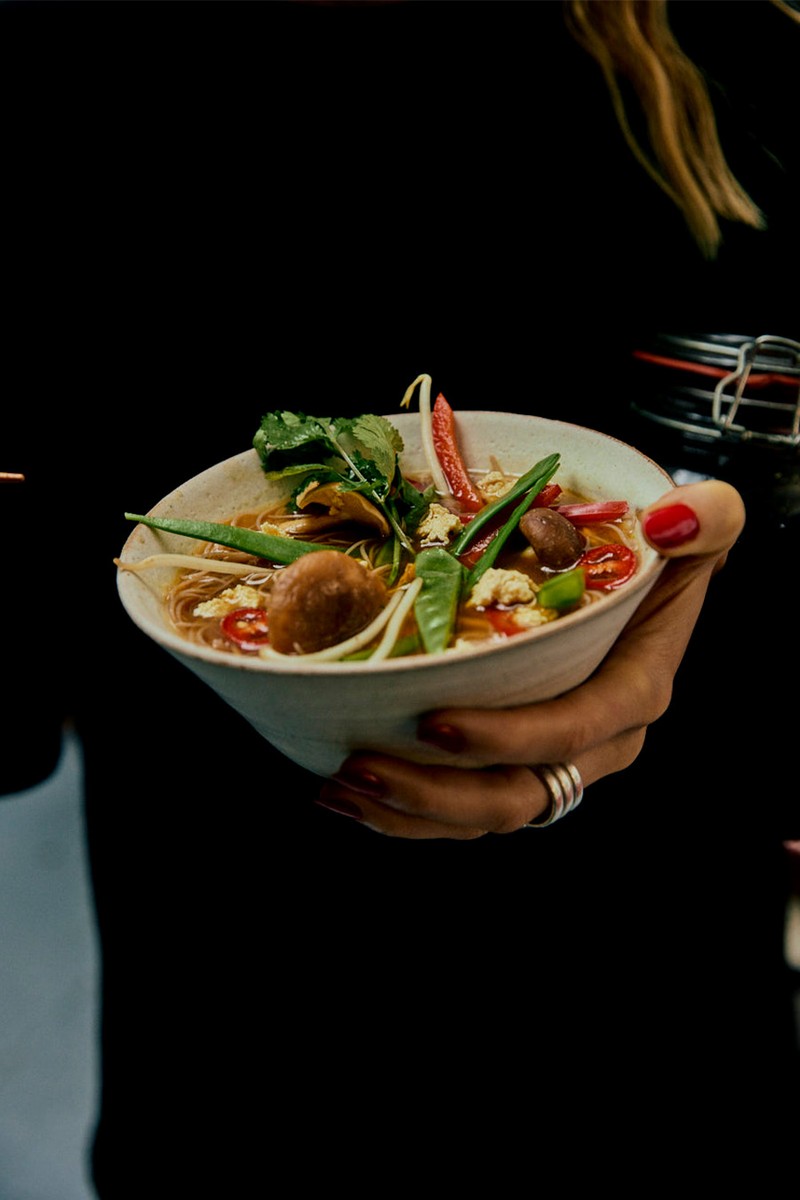
Leftovers Veggie Ramen
In a large pan, add the ingredients and cover fully with water. Bring this to a boil on high heat, then turn it down low and simmer for 1-2 hours or until you are happy with the taste. Adjust the seasoning as needed.
Once happy with the taste, strain the stock into a large container – you can store it in the fridge for up to a week or freeze for up to 3 months.
To make a ramen, add a bowlful of the stock to a pan and heat until simmering. Add some fresh vegetables – like mushrooms, mangetout and pak choi – and boil for 4-5 minutes.
Cook the ramen noodles according to the packet instructions, and soft boil two eggs.
Assemble each bowl by first adding the noodles, then pouring over the stock and the vegetables. Half the egg and place on top, then garnish with chilli oil, spring onions and sesame seeds, if using.

Seafood Ramen
Heat the oil in a large wok or frying pan over high heat. Add the salmon and prawns, and cook for 5 minutes, then add the mussels, scallops and sesame oil. Toss together and cook for a further 3 minutes.
Add the stock, bring to the boil and turn off the heat. Add the yuzu seasoning and fish sauce.
Cook the ramen noodles according to the packet instructions, drain them and divide them between 2 bowls.
Top the noodles with the broth, then add the pak choi or spring greens. Quickly blanch the samphire in boiling water for 2 minutes, then add this on top of the greens.
Discard any mussels that haven't opened, then divide the cooked seafood between each bowl, making sure the prawns go on last. Garnish with additional yuzu seasoning, chillies and coriander, if you like. You can add 1 teaspoon of gochugaru for some added heat.
DISCLAIMER: We endeavour to always credit the correct original source of every image we use. If you think a credit may be incorrect, please contact us at info@sheerluxe.com.
